Social Care Services, Scotland, 2014
Information on Home Care Services, Direct Payments, Community Alarms and Telecare, Meals services and Housing Support Services.
This document is part of a collection
2. Social Care Summary Information
This section provides a summary of the data collected on the 148,300 unique clients identified as receiving Home Care, Community Alarm/Telecare, Housing Support, Direct Payments or Meals Services in the 2014 Social Care Survey. Figure 3 shows how many clients received each of these services. The largest group is those receiving Community Alarms and/or Telecare, with nearly 112,000 clients, followed by Home Care with nearly 62,000 clients.
Figure 3: Social Care Client by type of services, all ages, 2014
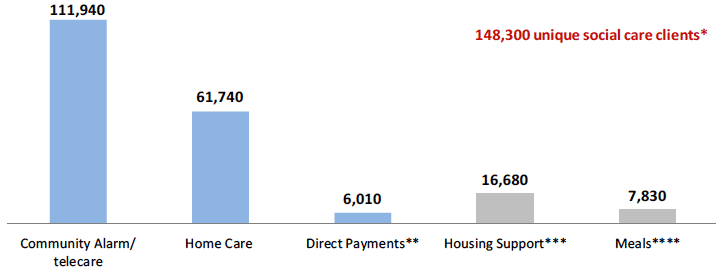
* Clients can receive multiple social care services.
** Direct Payment information is for the financial year 2013/14.
*** Housing Support is not reported on in this publication - summary data is available in the accompanying spreadsheet.
**** Three Local Authorities did not submit Meals data for 2014
Source: Social Care Survey 2014
Figure 4 looks at the breakdown of 2014 Social Care clients by age and gender. It shows that the proportion of clients who are female increases with age; 52% (14,300) of clients aged 18-64 are female, compared with 69% (81,000) of clients aged 65+. Factors that affect this pattern include women on average living longer than men and that women being more likely to be living alone as they get older (this is explored in more detail later on). Figure 4 also shows that the 0-17 age group accounts for a comparatively small proportion (less than 2%) of clients, which is why they do not have their own section in this report, as per the 18-64 and 65+ age groups.
Figure 4: Age and gender of Social Care clients, 2014
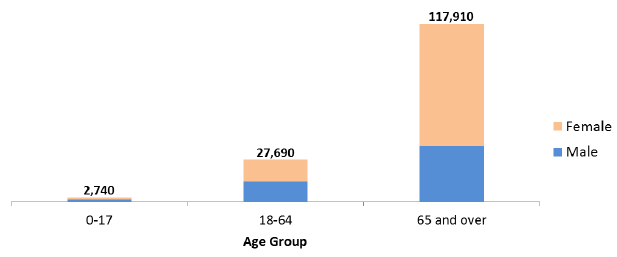
Source: Social Care Survey 2014
Note: 60 individuals did not have gender information entered.
The rates per population of clients receiving any combination of the Social Care services listed above varies between the 32 Local Authorities in Scotland. Figure 5 shows that Aberdeenshire has the lowest rates (around 17 clients per 1,000 population), while Shetland has the highest (around 43 clients per 1,000 population).
The number of Social Care clients in an area will depend on demand for services. Some of the variation may also reflect the ability of a Local Authority to record all services. In particular, Housing Support services may be under-recorded in some areas (see Background Note for more details).
Figure 5: Rates of Social Care clients, all ages, per 1,000 population, 2014
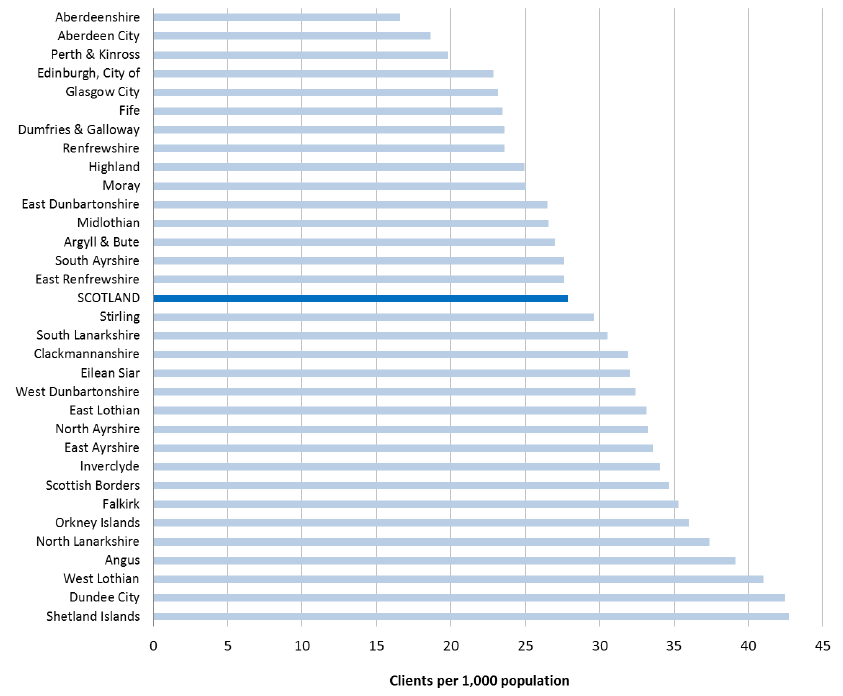
Source: Social Care Survey 2014
Population data: National Records for Scotland mid-year population estimates 2013 (latest available).
Table 1 shows that amongst the 2014 Social Care clients for whom ethnicity information was known, 99% were recorded as being White.
Table 1: Ethnicity of Social Care clients*, 2014
| Ethnic Group |
Clients* |
Percentage** |
|---|---|---|
| White |
96,570 |
99% |
| Other ethnicity |
1,230 |
1% |
* Ethnicity information was unavailable for 50,540 clients.
Source: Social Care Survey 2014
Figure 6 shows that 54% of 2014 Social Care clients were living on their own, and that female clients are more likely to live alone (57%) than male ones (47%).
Figure 6: Living arrangements of Social Care clients*, 2014
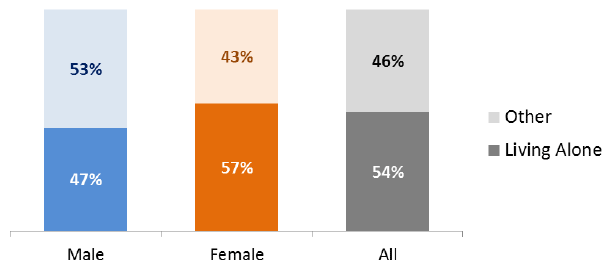
*70,380 cases with no living arrangements recorded.
Source: Social Care Survey 2014
Figure 7 (over the page) shows the breakdown of 2014 Social Care clients by age and client group (the reason for needing a social care service). This shows that 85% of clients with Learning Disabilities are aged under 65, compared with 24% with a Physical Disability.
Figure 7: Client Group of clients receiving Social Care services, 2014
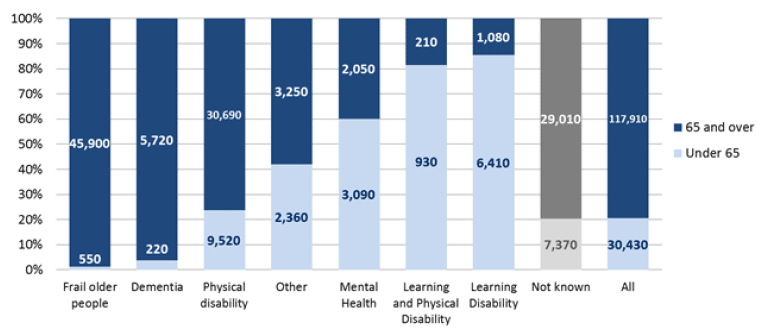
Note: "Other" includes addictions, palliative care and carers.
Note: "Dementia" is known to be under recorded in the social care management information system.
Source: Social Care Survey 2014
The remainder of this section provides further detail on the Home Care services and Direct Payments received by clients of all ages.
Figure 8 shows who was providing Home Care for clients in each year from 2007 to 2014. In March 2014, just over 50% of clients were receiving services provided solely from Local Authorities. This proportion has been decreasing each year since 2007. The proportion of Home Care hours being provided solely by Local Authorities was 36% in March 2014 and has again decreased every year since 2007. The difference between these proportions and those seen for client numbers reflects the fact that the private and voluntary sector, on average, provide larger packages of care.
Figure 8: Home Care provision by Service Provider, 2007 to 2014 (all ages)
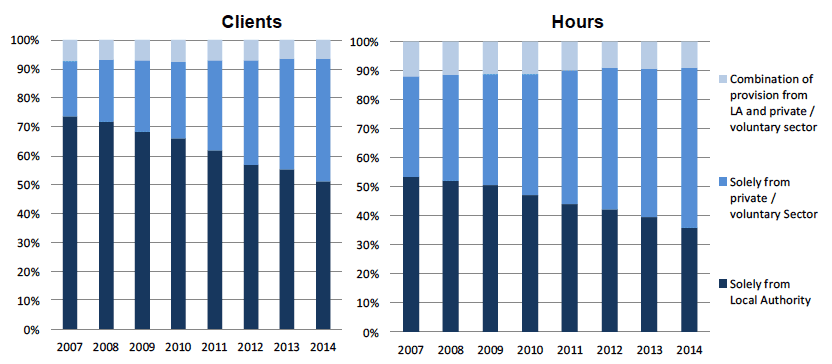
Source: Social Care Survey 2013 and 2014, Home Care Census (pre 2013)
Figures 9 and 10 show the age breakdowns of Home Care and Direct Payments clients in March 2014 and 2013-14 respectively. Figure 9 shows that 82% of Home Care clients are aged 65+, whereas Figure 10 shows that only 39% of Direct Payment clients are aged 65+.
Figure 9: Home Care clients by age, 2014
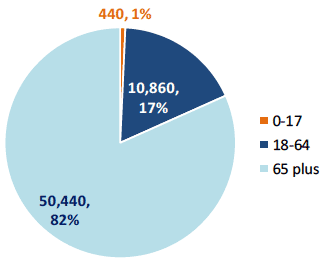
Figure 10: Direct Payments clients by age, 2013-14
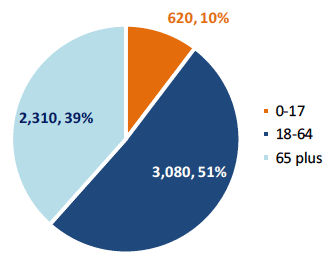
Source: Social Care Survey 2014
Contact
Email: Steven Gillespie
There is a problem
Thanks for your feedback